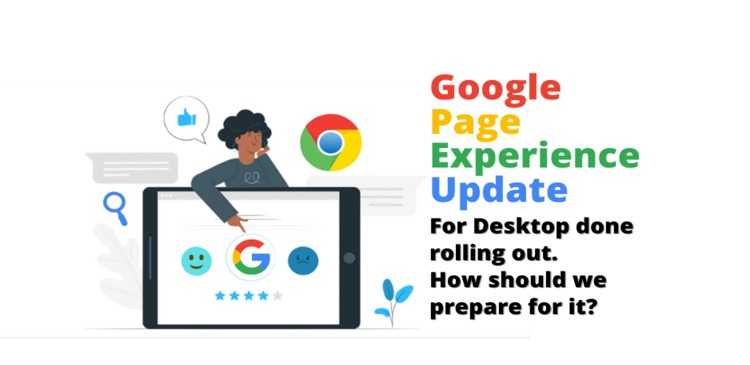Google Page Experience Update For Desktop Done Rolling Out How Should We Prepare?

Developed on June 16th, 2021, Google’s broad core algorithm update called ‘The Page Experience Update’ is intended to bring a better experience to users by prioritizing pages that offer a better quality page performance such as faster loading time and stable pages. With the 2021 Page Experience update, three new metrics are introduced to measure both speed and overall page experience. These new metrics are called Core Web Vitals. The three Core Web Vitals are:
- Largest Contentful Paint (LCP) – It measures the time taken for a large block of visual content on a page to load.
- First Input Delay (FID) – This measures how fast it takes for a page to become responsive.
- Cumulative Layout Shift (CLS) – These measures page stability. The cumulative layout shift is the overall shift in a page’s layout as it loads.
IMPACT OF PAGE EXPERIENCE UPDATE ON SEO
Since Core Web Vitals becomes a lightweight ranking factor, there is an incentive to optimize your website from an SEO standpoint. If your site performance isn’t up-to-speed, users might most probably navigate elsewhere. Even though improving page experience should be about improving the overall quality of your page, it doesn’t mean you have to give up on quality content creation efforts or other UX practices in the process. The reason why Google emphasizes the importance of Page Experience is that most sites need to improve. When more people try to bring up their page speed, users will see an improvement in their web surfing experience. In addition to this, search engine result pages (SERPs) will be more competitive in terms of site performance.
HOW TO PREPARE FOR GOOGLE PAGE EXPERIENCE UPDATE
As one of the best digital marketing and SEO companies based in Kerala, here are a few tips on how to prepare for a Google page experience update so that you can focus on and improve user experience.
-
Increase Site Speed
Increasing site speed is one of the most obvious places to start. An increase in load time also leads to an increase in bounce rate. Site speed is crucial to providing an excellent user experience. The easiest tool to optimize this problem is offered by Google itself. This tool is known as Google’s PageSpeed Insights. All you have to do is enter your domain URL. It will then score your site on a scale from 0 to 100 with 0-49 being poor, 50-89 requiring improvement, and 90-100 being ideal. It also breaks down your Core Web Vital scores and recommends suitable optimizations to improve these scores.
Other clear ways to increase site speed can be to-
- Compress large images
- Reduce redirects
- Fixing 404 errors and
- Updating your web server
-
Fixing Page Structure and Design Issues
Using heatmaps will help determine usability issues. They display where the user navigates to, places they get stuck at, or pages where they bounce off. Heatmaps provide valuable insight into page design and structure. If your site has poor design or structure, you’ll be able to notice it easily while analyzing the heatmap of your server. For a website to be attractive and boost conversion rates, user experience is a key factor. For that very reason, if a customer cannot navigate through a website with ease due to its poor structure and design, its sales are probably going to drop.
-
Analyzing and Improving Bounce Rate
Bounce rate is a clear sign of a bad user experience. If someone clicks your site and bounces immediately, it’s a sign for Google that the user is not receiving what it wants from that particular page. As a result, this will lead to a lower site rank for that specific search query. The majority of web bounce rates fall between 26 to 70 percent.
Bounce rates can be decreased by-
- Limiting pop-ups that block your content
- Make your site and content readable by using bullets, headers, short sentences, paragraphs, etc.
- Limiting external links and prioritizing internal links.
- Using CTAs wisely.
- Increasing a user’s time on the page by means of videos and infographics.
- Considering takeover CTAs and strategic pop-ups that arise when a user is about to leave a page.
-
Making a site mobile-friendly
Not having a mobile responsive site can be the reason for having a low score. A responsive site is a site where the page loads according to the size device screen. This is considered to be the best way to ensure a mobile-friendly experience. This way you can create a consistent experience for every user, no matter the platform.
Here are some tips to increase mobile-friendliness for your page-
- Using variable fonts since not all fonts seen on a desktop appear on mobile devices.
- Scrollable sites
- Prioritizing white spaces.
- Making buttons big enough for mobile devices.
- Not hiding your site’s search bar.
-
Improving Site Security
A part of the page experience update focuses on on-site security and browsing safety. It is important for you to ensure that your site provides a secure HTTPS connection. Once your site is secure, check your page for malware. Enlist an expert to fix your site if it has malware. There are free online tools such as Google Safe Browsing, Web Inspector, and ScanTitan that can help make this process easier. These tools offer services that are capable of fixing problems that you may face.
-
Offer Compelling Content
Focus on content. It is one of the best things you can do to prepare for the Google Page Experience Update. It’s also the best way to ensure that your users are enjoying the page experience as expected. Even with the Page Experience update, quality content is the leading factor in page ranking. By providing content helpful for your users, you can enjoy a superior user experience.
Here are some ways to deliver useful and quality content:
- Write about the right things with proper research.
- Define your audience.
- Create better content than others.
- Update your content regularly.
Even though there’s a lot to consider ahead of the Page Experience update, working towards these tips will ensure your site stays on top when the next update hits. Do not forget that content is crucial and that all that matters, in the end, is that you’re capable of providing a quality, superior and helpful user experience for your users.




